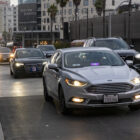A shortage of drivers has reportedly been affecting both the ride-hailing and taxi industries — there aren’t enough to meet demand right now. But as demand rises and other factors collide, dynamic pricing on ride-hailing apps has spiked the cost of Uber and Lyft rides, sending some customers to taxis instead. Mark Gruberg, a San Francisco taxi driver since 1983 and a board member of the San Francisco Taxi Workers Alliance, talked with “Civic” about what this has meant for cab drivers and how he and others have stayed busy with advocacy even if they haven’t been driving in the pandemic. The alliance has been trying to get funding for wheelchair accessible taxis and support drivers whose medallions — taxi permits that costs $250,000 — have been foreclosed on.
While customers switching from ride-hailing apps to taxis does help drivers who need the business, Gruberg said, that doesn’t mean drivers aren’t struggling to make ends meet. Rates are set by the city, and drivers are responsible for many of their own costs whether they have their own cab or they lease a car from a company.
“When things are bad, drivers can take home little or nothing, or even less than nothing, meaning that they’re actually in a hole and they owe the company more than they brought in in gross revenue in the course of the shift. When things are good, the driver can go home with money in their pocket, but the risk is on the driver. And I don’t think the public can have any assurance that the taxi driver is making a reasonable income or doing any better than an Uber or Lyft driver.”
— Mark Gruberg
A segment from our radio show and podcast, “Civic.” Listen at 8 a.m. and 6 p.m. Tuesdays and Thursdays at 102.5 FM in San Francisco, or online at ksfp.fm, and subscribe on Apple, Google, Spotify or Stitcher.









